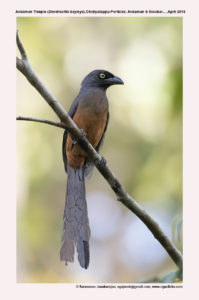Andaman Treepie

Andaman Treepie Dendrocitta baileyi
Etymology:
- Dendrocitta : Greek word Dendron- tree; kitta – magpie.
- Baileyi : Named after American naturalist Dr Alfred Marshall Bailey (1894–1978)
Distribution inIndia: Resident in Andaman Island in India
Description: Size of32 cm; Wt. of 92–113 g. It is a small Treepie, the smallest of genus, with large white wing patch and pale eyes. It has a long, strongly graduated tail, central pair of feathers little longer than the next, short bill less stout than others of genus and with more gently curved culmen. The head and neck are dark bluish-grey, shading into blackish on face and forecrown; the upperparts are dark tawny-brown, brighter rufous on rump, becoming grey on uppertail-coverts; the upperwing is black, white patch at bases of primaries and inner secondaries; the tail is blackish, shading to dark grey over basal half of central feathers. The underparts are bright rufous, shading into greyish on upper breast and chestnut on undertail-coverts; the iris is yellow; bill is blackish; legs are blackish-grey. Both the sexes are similar. The juvenile has sooty reddish-brown hood, darker and redder upperparts with reddish feather margins, greyish-brown fringes of wing-coverts, shorter and greyer tail, and olive iris; iris becomes brighter green before turning into yellow of adult.
Habitat: It is found in dense, humid evergreen forests, where it favours the largest trees.
Food Habits: It is omnivorous. It is found in small parties following mixed-species bird waves. It works its way through mid-canopy level, especially in company of Andaman Drongos.
Breeding Habits: They breed in March-May. They are solitary breeders. The nest is a rather flimsy structure of fine twigs and grasses, smaller and neater, more compact, lined with fern rootlets and other soft plant material, well hidden above ground inside dense foliage of small forest tree. They lay a clutch of 3 eggs.